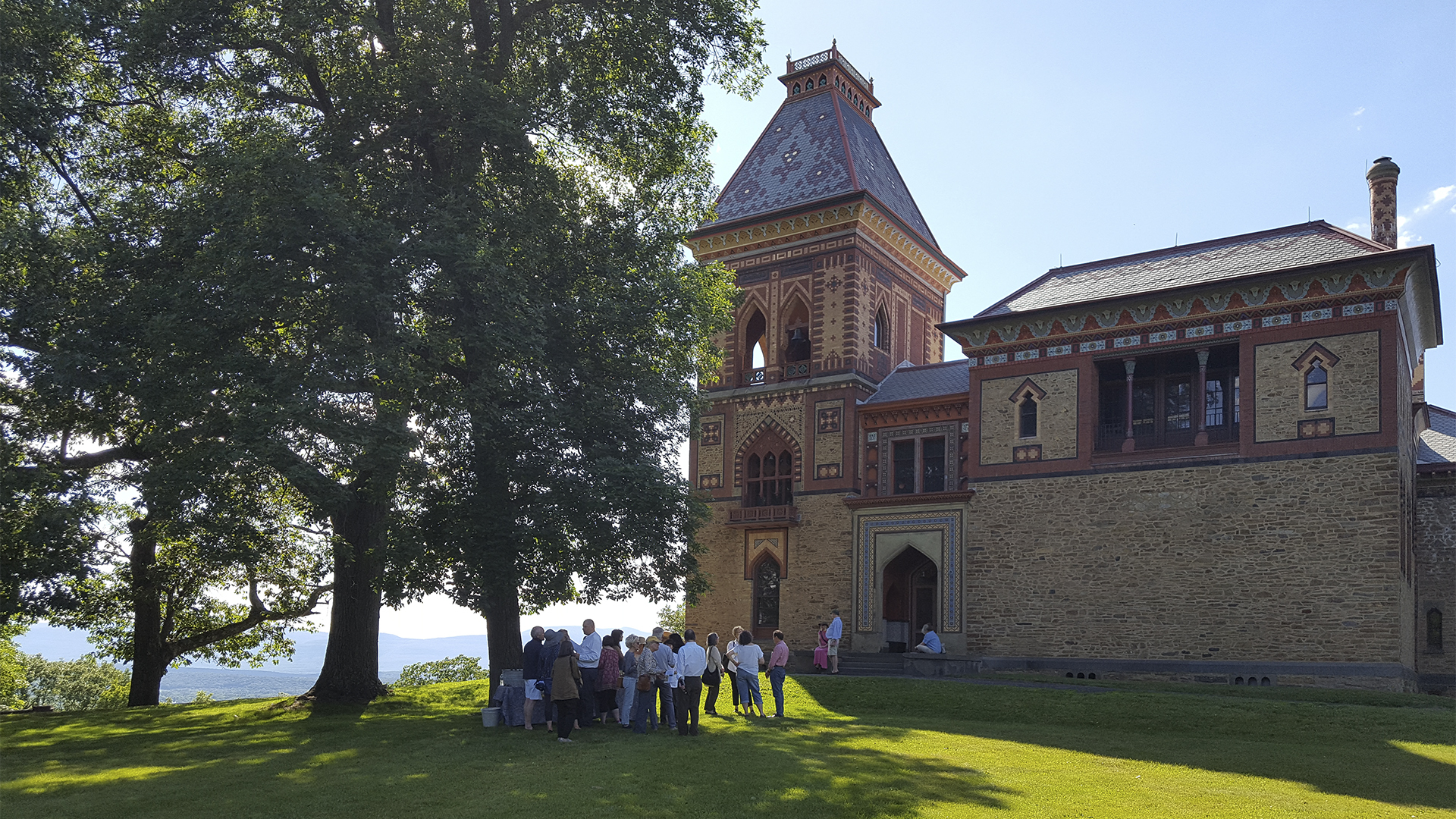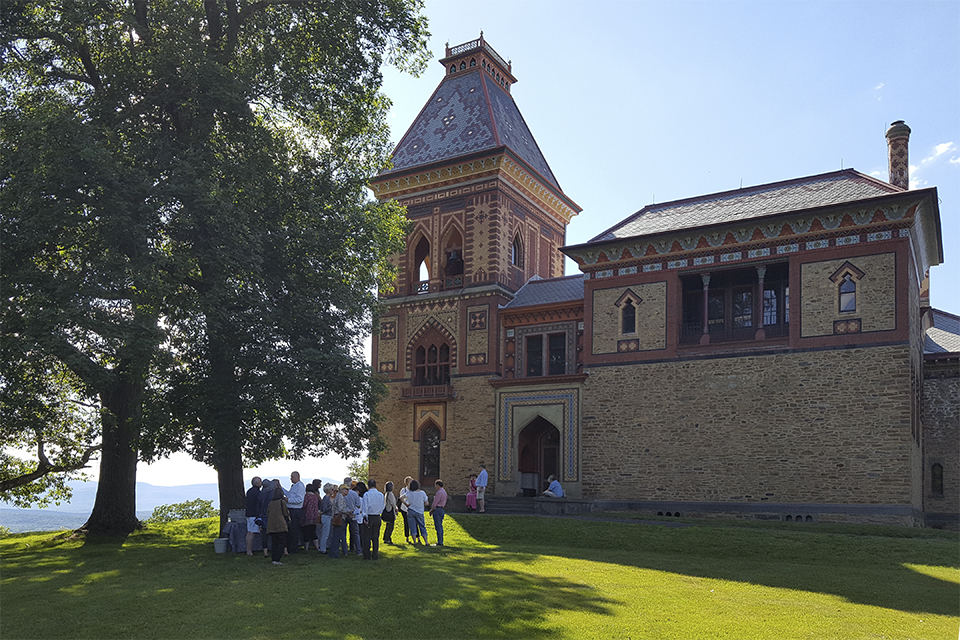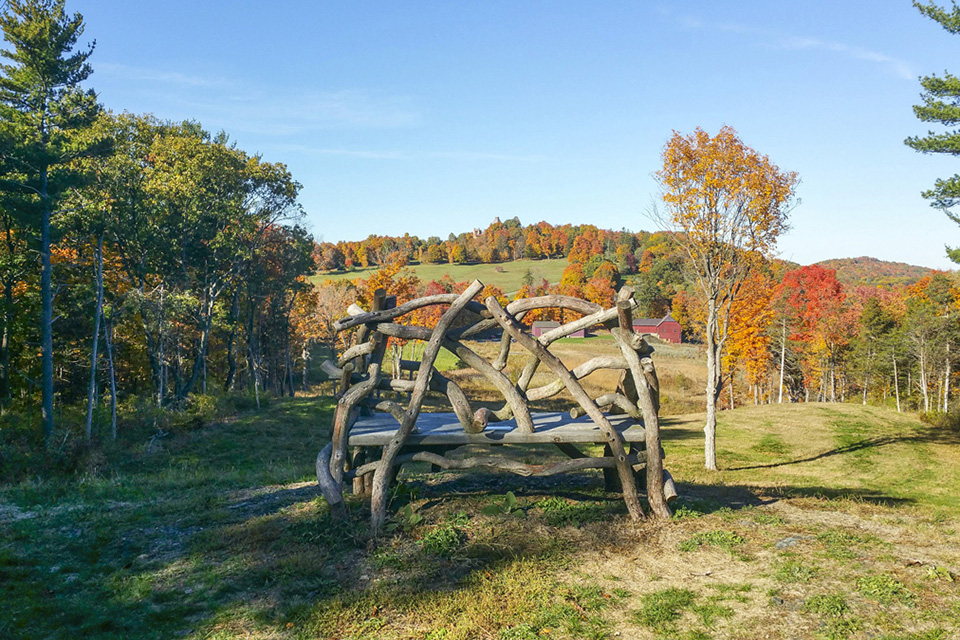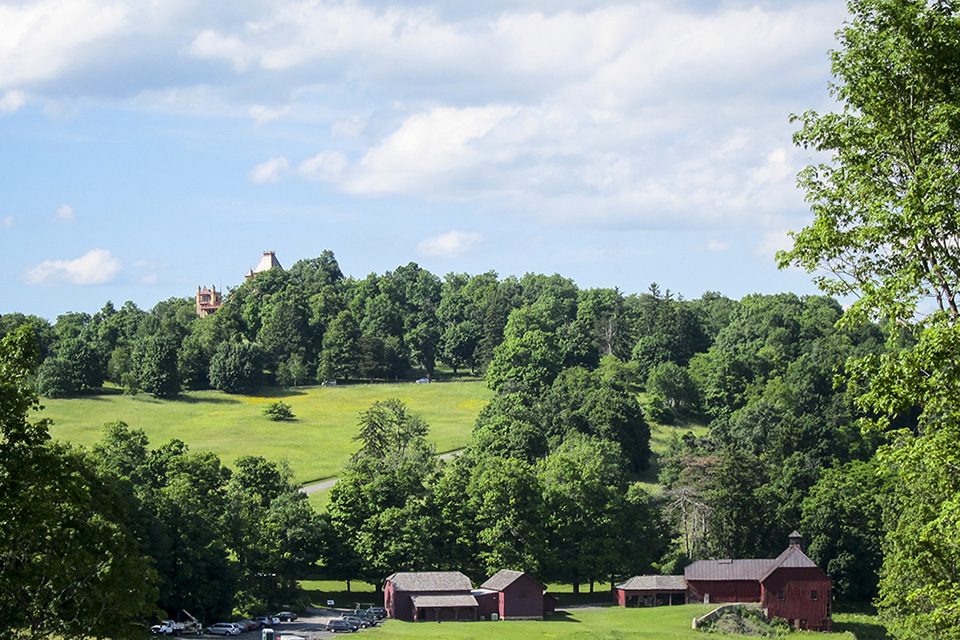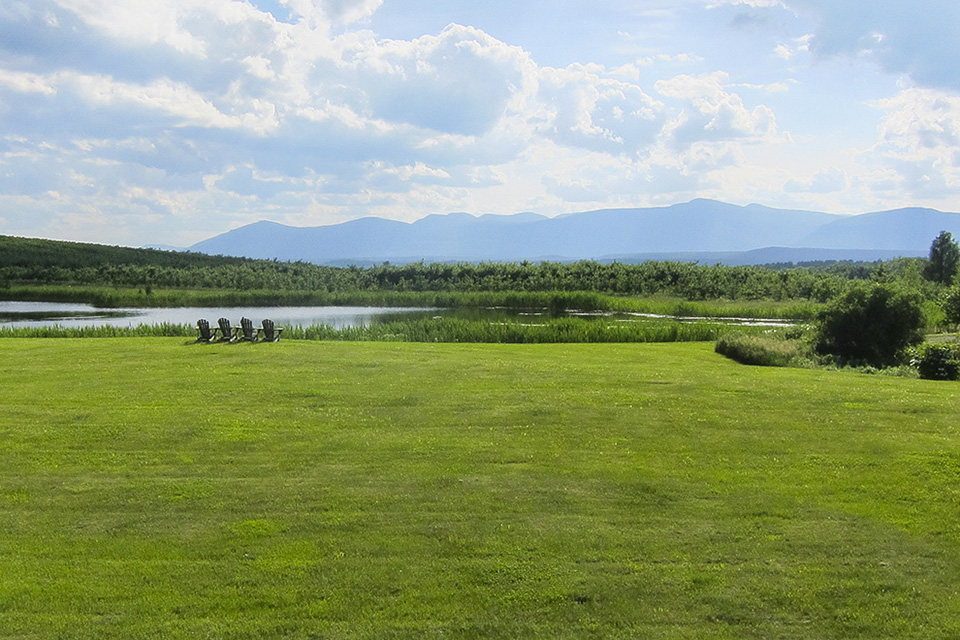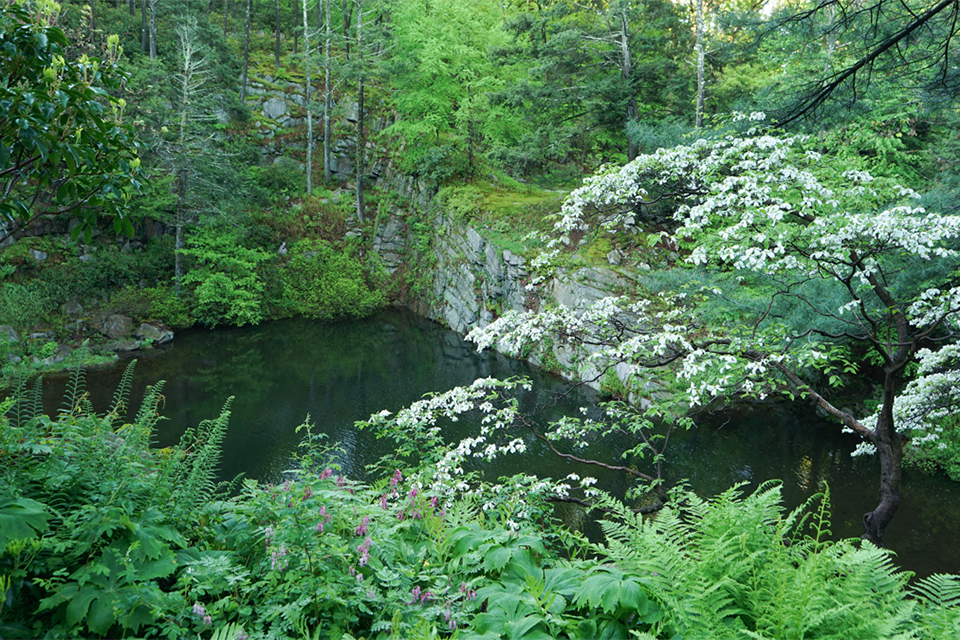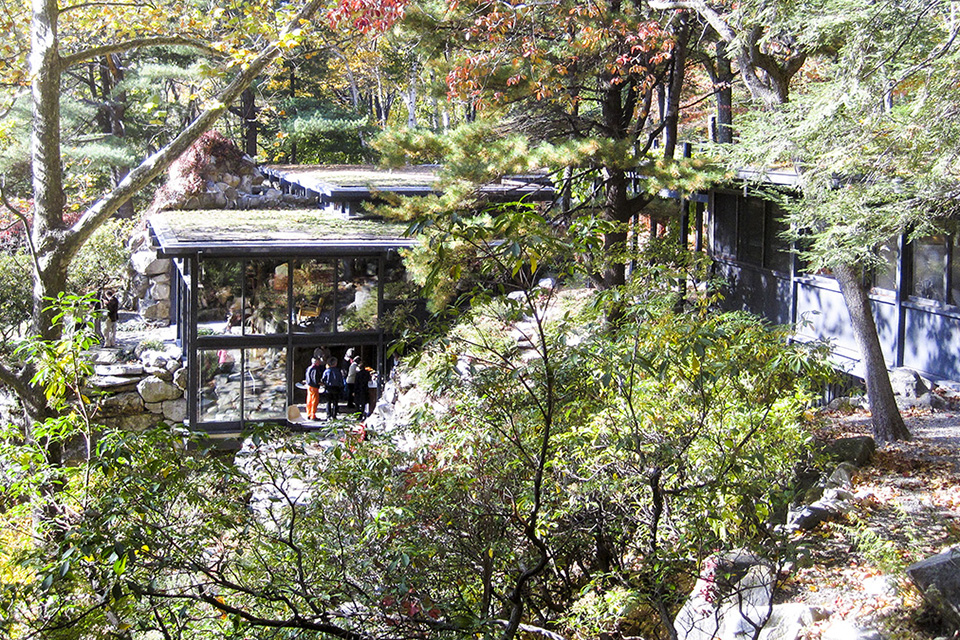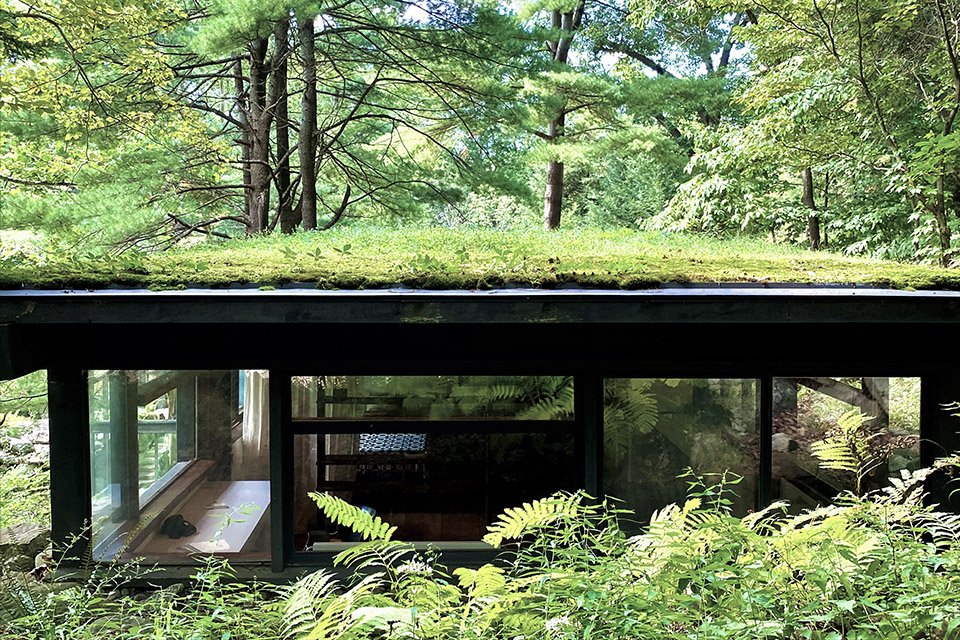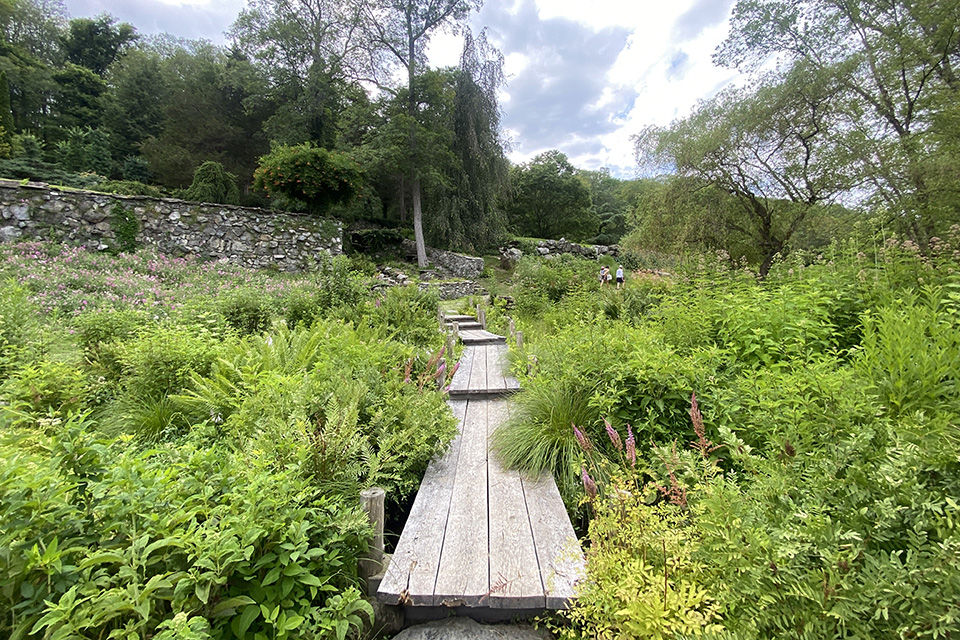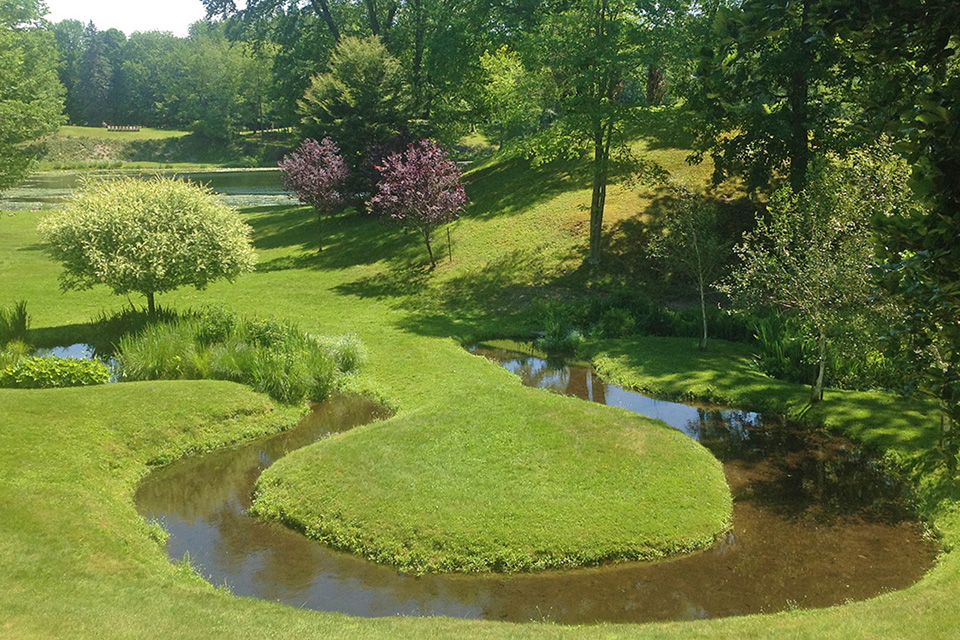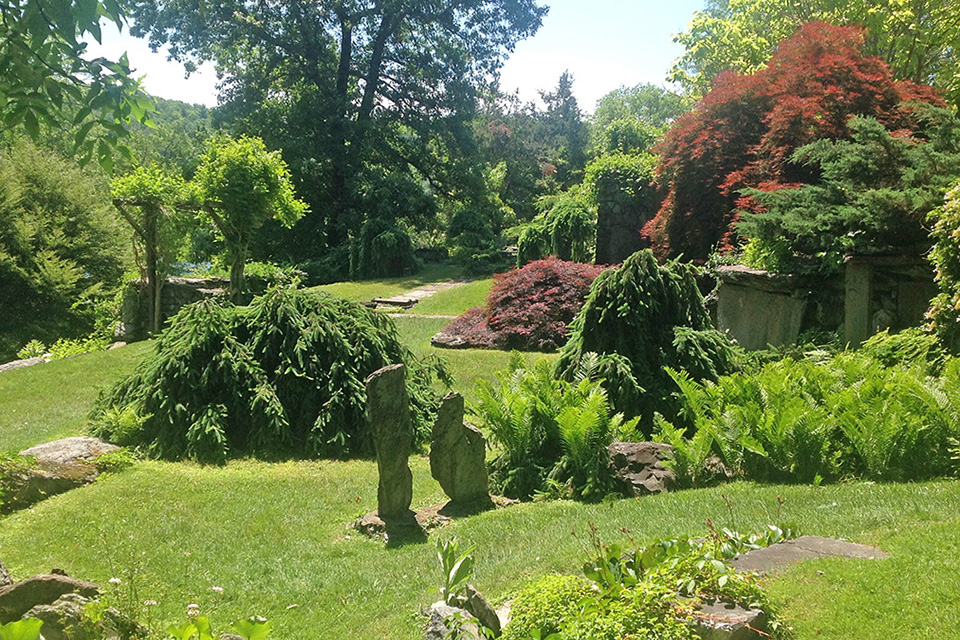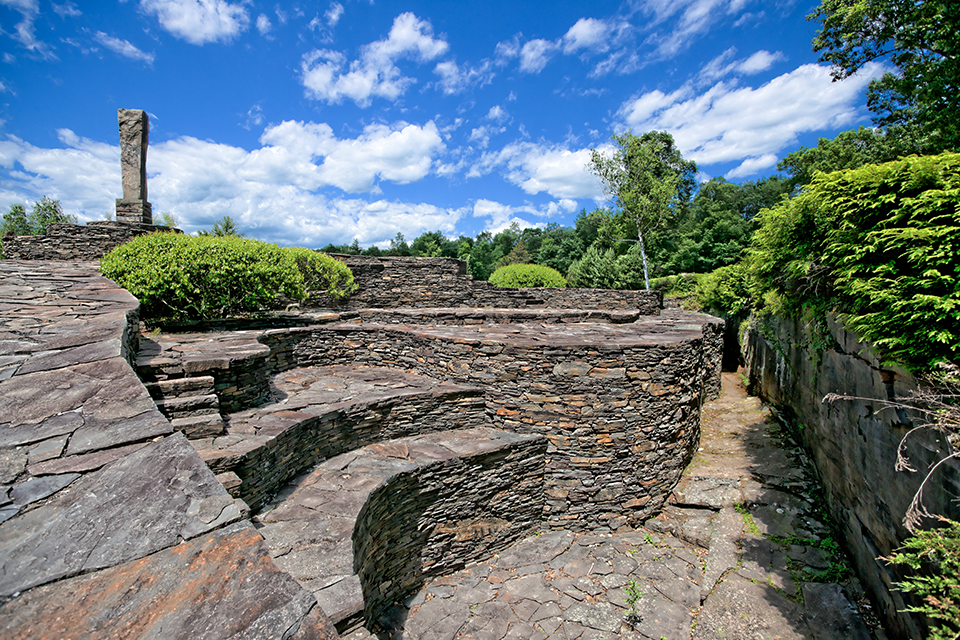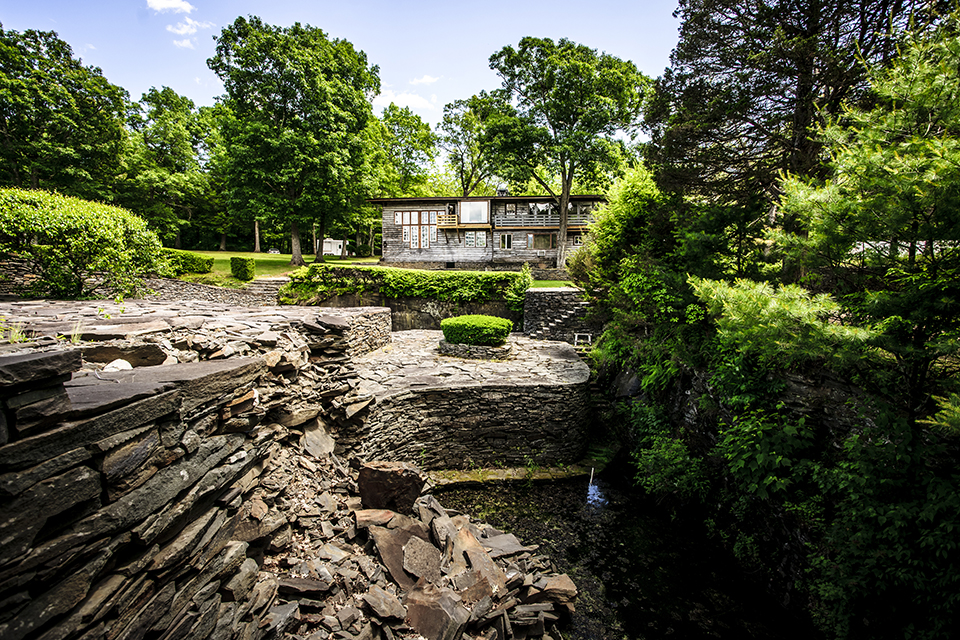The Hudson Valley possesses a unique and unrivaled cultural landscape legacy, especially as the locus of the Hudson River School art movement and the birthplace and final resting place of landscape gardener, horticulturist, author and tastemaker, Andrew Jackson Downing (1815-1852). Since the nineteenth century aspects of its landscape have been artfully and painstakingly shaped, with the careful siting of architectural elements and the creation of borrowed and panoramic views of the Hudson River, Taconic and Catskill Mountains, and the Hudson Highlands. Features of the region’s varied topography have been highlighted, including its meadows, farmland, woodlands, bluffs, hills, and ravines. Agriculture, wilderness, and leisure have long coexisted side by side here, as have private and public lands.
Each of the sites below are the result of decades of passion and dedication on the part of one or a few individuals. Art is imbued within the landscapes; indeed, these landscapes are themselves works of art, but they suffered from neglect and/or deferred maintenance, lack of knowledge of their historic significance, or in the case of Opus 40, hurricane damage, which put their character-defining features and original design intents at risk. TCLF enrolled each in its Landslide program and worked to bring greater visibility to the sites, and deepen the public’s understanding through lectures and symposia, dialogues, and tours, and in some cases working directly with key stakeholders and boards of directors providing technical assistance. TCLF’s engagement with the cultural landscapes of the Hudson Valley has been and will continue to be significant and impactful.
The result of decades of passion and dedication, this 185-acre property, surrounded by woodlands, is located approximately 100 miles north of New York City. Set within a natural bowl that wraps around the 40-acre Tyrrel Lake, Innisfree – its name references a poem by William Butler Yeats – affords visitors a sense of seclusion and privacy. A masterpiece of Eastern influence on a distinctly American landscape, the grounds were designed by painter Walter Beck, his wife, gardener and heiress Marion Beck, and landscape architect Lester Collins.
Background
The Becks acquired the property in the 1920s and in the early 1930s built a Queen Anne-style mansion, which is no longer extant. Instead of surrounding the residence with typical English gardens, the Becks went on a yearlong sojourn to search for an alternative. In London Walter Beck discovered the scroll paintings of the garden of eighth-century Chinese poet and painter Wang Wei. Beck was prompted to experiment with a series of Asian-inspired gardens on the grounds of Innisfree, using Wei’s concept of distinct garden vignettes. Beck created a series of self-contained landscapes using natural elements such as rocks, streams, and plants to compose and frame views. The three-dimensional compositions, which he termed “cup gardens,” are intended to be both viewed as scenes and experienced directly. In 1938 the Becks met and began collaborating with Lester Collins.
From 1939-1940, before pursuing a master’s degree from the Harvard University Graduate School of Design, Collins traveled throughout China, India, Japan, and Tibet with fellow landscape architect John Simonds, finding many similarities to Modernist design in these ancient cultures (the Becks never traveled to Asia). He returned to Japan in 1954 as a Fulbright Scholar, studying traditional garden design and construction methods, while working with a native scholar of medieval Japanese to translate the 1,000-year-old Sensai Hisho, or Sakuteiki, the seminal Secret Garden Book, into English.
The Becks found a kindred spirit in Collins, whose work on the Innisfree landscape became a lifelong passion. Embracing the Becks’ vision, Collins transformed their inspiration into a unified whole. Over five decades he experimented with, edited, and refined his design, using Chinese, Japanese, Modernist, and Picturesque principles to create new gardens and tie Beck’s “cup gardens” into the broader landscape. Together, Walter Beck and Collins selected stones from Innisfree’s rocky woodlands and set them into the landscape, often inspired by the ideas and specific instructions found in the Sakuteiki. Linking set pieces by carefully choreographing movement and experiential tone, Collins created a distinctly American strolling garden.
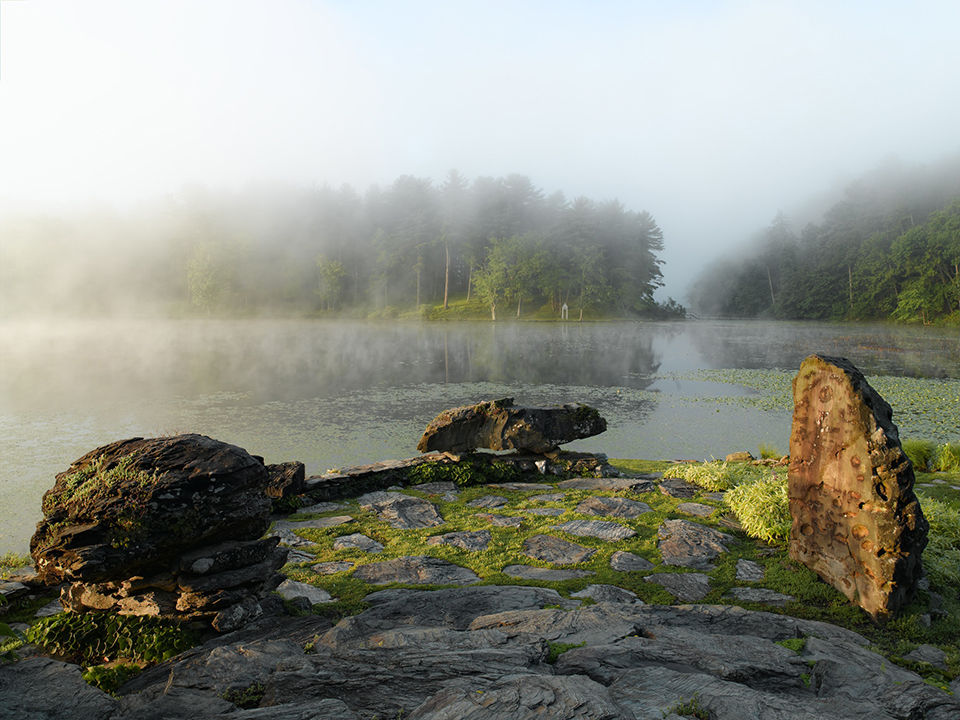 Innisfree Garden, Millbrook, N.Y., 2019. Photo courtesy Innisfree Foundation.
Innisfree Garden, Millbrook, N.Y., 2019. Photo courtesy Innisfree Foundation.
Following Marion Beck’s death in 1959, responsibility for the garden transferred to the Innisfree Foundation, which was created to preserve the property; it opened to the public in 1960. Collins ran Innisfree as a public garden for 33 years until his death in 1993. With little money and no staff, he created a host of new features and more than doubled the size of the garden, wrapping it around the lake to create a physical and experiential journey. The garden was maintained with extreme thrift, relying on income from admissions as well as from a small endowment that was created when outlying acreage was sold in the 1970s.
After Collins’ death, members of his family continued to manage the garden. Collins’ low-cost, environmentally sensitive maintenance practices were perpetuated, and the landscape remained relatively intact. The family, however, did not have the ability to raise significant funds, thus deferring major repairs such as mending stone walls and updating utilities.
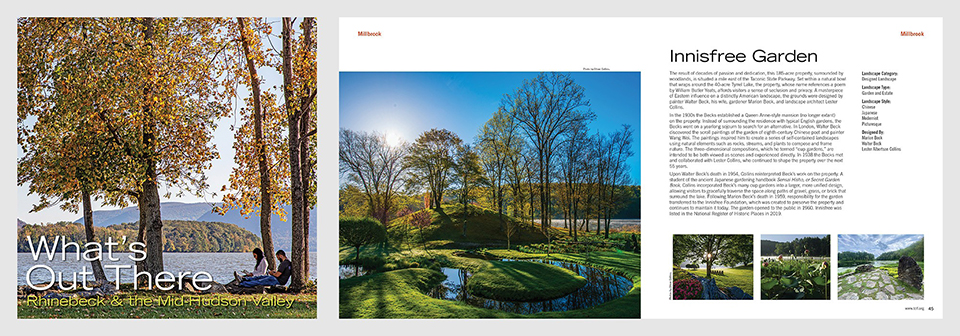
What’s Out There Rhinebeck & the Mid-Hudson Valley guidebook, 2023. Image courtesy The Cultural Landscape Foundation.
Advocacy and Engagement for Innisfree
Unable to launch new initiatives or hire professional staff, the Collins family saw the need for change and reached out to TCLF, which in 2012 enrolled Innisfree in the Landslide report and digital exhibition, Landscape and Patronage (it included the Hannah Carter Japanese Garden, also in this year’s report). The report and exhibition honored visionary patrons and organizations and the sites they helped create, aiming to highlight their accomplishments and inspire new generations of patrons and philanthropists.
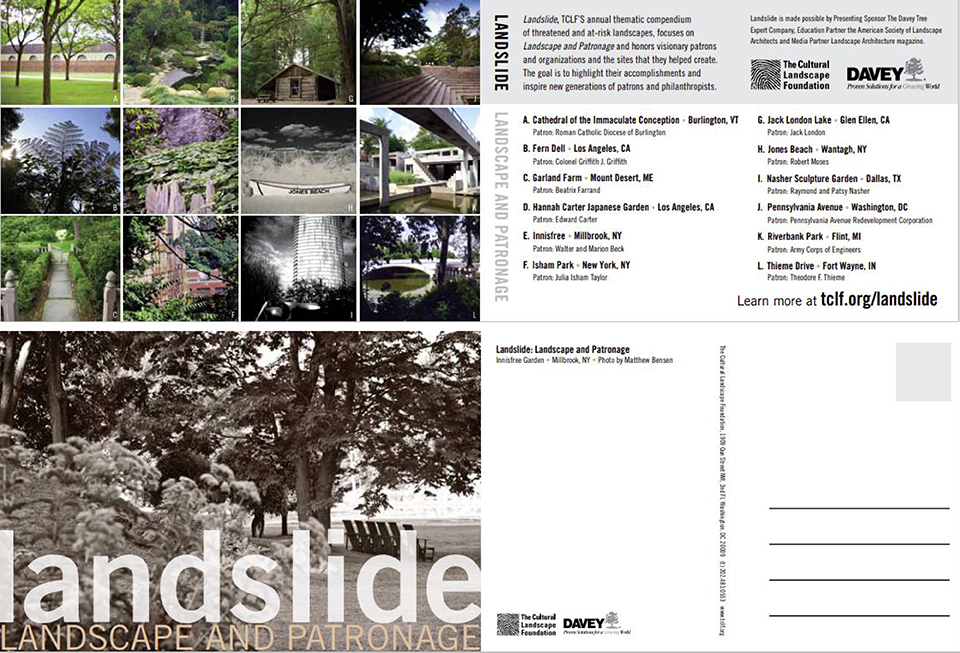 Landscape and Patronage Postcard Park, 2012. Image courtesy The Cultural Landscape Foundation.
Landscape and Patronage Postcard Park, 2012. Image courtesy The Cultural Landscape Foundation.
In 2013 Innisfree’s staff expanded, with the addition of a part-time landscape curator. New trustees, many with professional abilities, were gradually added to the board. Public programming, community outreach, a membership program, and fundraising events were initiated and a five-year grant from New York State was secured in addition to several smaller grants. In 2015 the Trustees of Innisfree Foundation engaged TCLF President and CEO Charles A. Birnbaum to work with them and key stakeholders to understand the differences between preserving an important historic landscape and running a public garden, and explaining what steps could be taken to appropriately steward the landscape and secure its future. Among his recommendations was to pursue listing in the National Register of Historic Places and, ultimately, National Historic Landmark designation. In 2019 Innisfree was listed in the National Register; the nomination itself received a New York State Historic Preservation Award from the Office of Parks, Recreation and Historic Preservation.
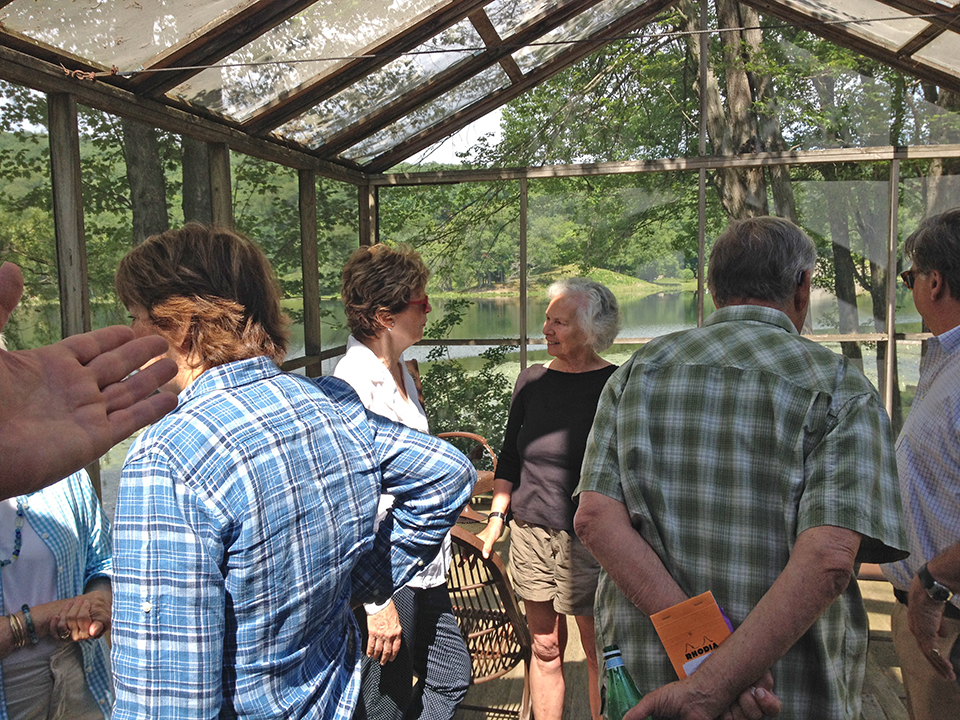 Meeting between trustees of Innisfree Foundation and key stakeholders, facilitated by TCLF’s Charles A. Birnbaum, Innisfree Garden, Millbrook, N.Y., 2015. Photo by Charles A. Birnbaum, courtesy The Cultural Landscape Foundation.
Meeting between trustees of Innisfree Foundation and key stakeholders, facilitated by TCLF’s Charles A. Birnbaum, Innisfree Garden, Millbrook, N.Y., 2015. Photo by Charles A. Birnbaum, courtesy The Cultural Landscape Foundation.
Since then, the Innisfree Foundation has professionalized, hiring an Executive Director, Laura Palmer, in 2021, to work with landscape curator Kate Kerin; there are 21 paid staff, most of whom are part-time and seasonal, and five volunteer docents. More recently the Innisfree board adopted a strategic plan and brought in TCLF to help them integrate the plan within a broader set of overarching guidelines and principles for the site’s management. Innisfree has been featured in some TCLF programming including Garden Dialogues in 2018 and a What's Out There Weekend 2023. Innisfree also maintains a rich and extensive body of programming throughout the year that features the flora, fauna, environmental, and ecological aspects of the site, along with the landscape architecture of Lester Collins.
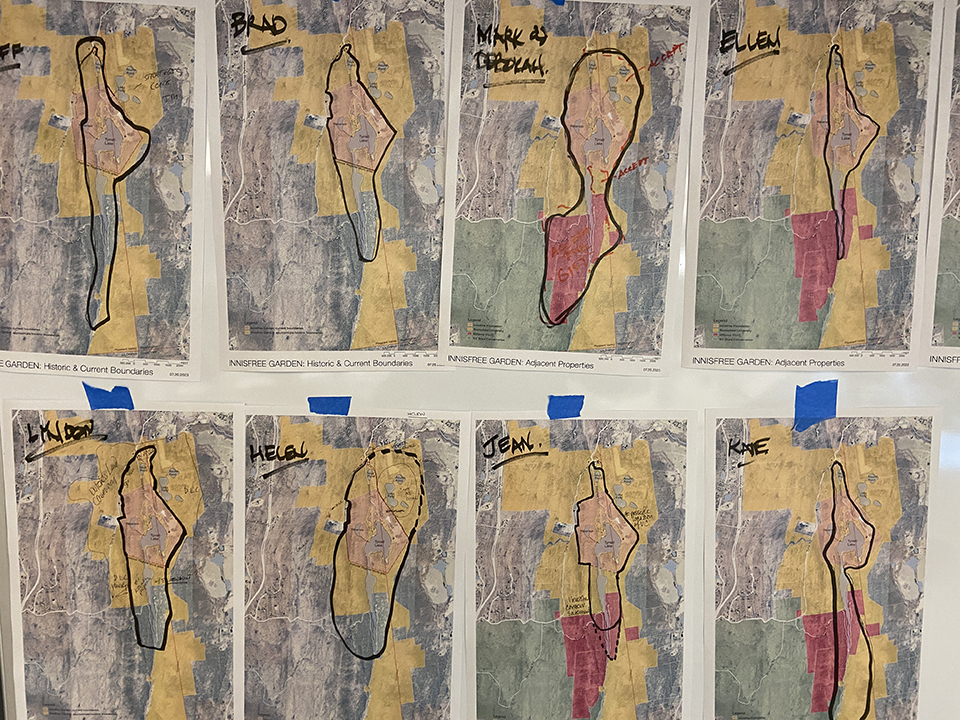 Return engagement to Innisfree: diagrams from strategic planning meeting with TCLF’s Charles A. Birnbaum, Innisfree Garden, Millbrook, N.Y., 2023. Photo by Charles A. Birnbaum, courtesy The Cultural Landscape Foundation.
Return engagement to Innisfree: diagrams from strategic planning meeting with TCLF’s Charles A. Birnbaum, Innisfree Garden, Millbrook, N.Y., 2023. Photo by Charles A. Birnbaum, courtesy The Cultural Landscape Foundation.
A recent New York Times feature noted: “Moving in and out of the spaces laid out across its wooded slopes, rocky outcroppings and meadows, we are the beneficiaries of several key garden-making strategies strongly influenced by Asian landscape design.” The article continues: “Using light and other raw materials, Innisfree’s makers shaped scenes that pull visitors through the landscape — although many of the cues seem almost subliminal. And each one reads differently depending on the time of day and the season. It’s the light at work.”
This 75-acre property in the Hudson Highlands, east of the Hudson River, was scarred by logging and quarrying before industrial designer Russel Wright and his wife and business partner, Mary Wright, acquired the site in 1942. The property was thickly covered with second growth woodland, littered with quarry pits, and generally unappealing. Over the subsequent 34 years Russel Wright sculpted the land, augmenting the native vegetation, stone outcrops, and steep slopes to create a garden that expresses the spirit of the place. An intensely personal work, Manitoga was designed entirely in reference to Wright's own taste, the needs and lifestyle of himself and his family, and the specific natural character of the site. Within Wright's oeuvre, Manitoga is the work that best epitomizes his ideas about American lifestyle and design.
Background
In the late 1930s Russel and Mary Wright began to look for land in the Hudson Valley. By then Wright was a well-known and prolific designer of objects for the home including furniture, appliances, textiles, and dinnerware. Through his elegant and functional designs, particularly his enormously popular "American Modern" line of dinnerware, he brought modernism to millions of Americans.
 Landscape prior to design intervention, Garrison, N.Y., circa 1940s. Image courtesy Manitoga/The Russel Wright Design Center.
Landscape prior to design intervention, Garrison, N.Y., circa 1940s. Image courtesy Manitoga/The Russel Wright Design Center.
Wright's approach to landscape architecture was based on delicately manipulating natural elements and “editing” the landscape over many years. Although he undertook some major changes, such as clearing, blasting, and earthmoving, his actions were generally as simple as pruning a single limb to reveal a view. Unlike other Hudson Valley estates where the Hudson River dominates the view, at Manitoga the river is only one element in a much more complex visual experience.
The design of Manitoga's landscape was conceived in relation to the site’s steep topography and its most conspicuous feature, an abandoned stone quarry. Wright re-routed a stream into the quarry pit, creating a thirty-foot waterfall, and dammed its other end, forming a pond for swimming. He positioned the largest and most substantial built feature, his house and studio, known collectively as Dragon Rock, within the northern edge of the quarry. Completed in 1961, the structures were designed by architect David Leavitt, using initial ideas and plans developed by Wright.
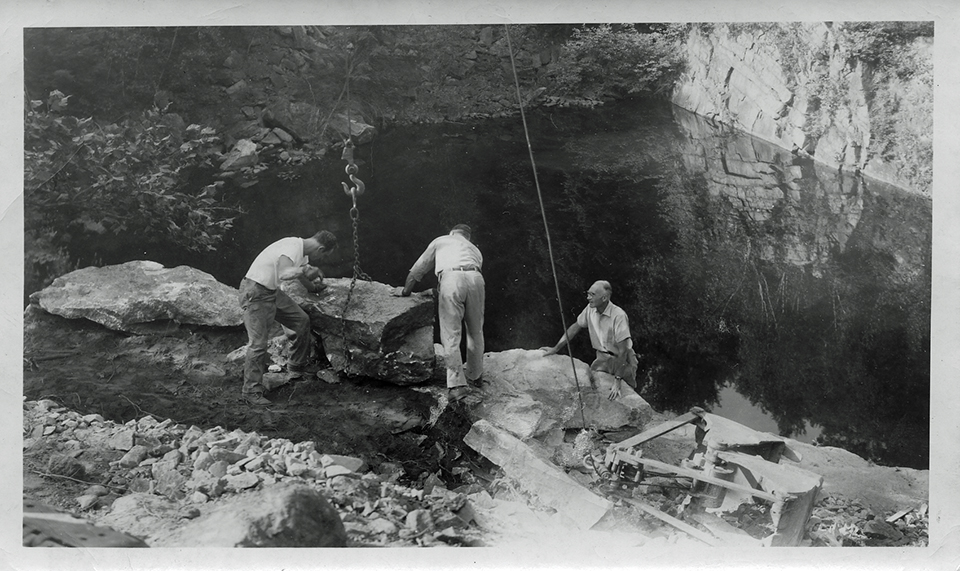 Wright (right) directing the placement of a boulder, Manitoga, Garrison, N.Y., circa 1960s. Image courtesy Manitoga/The Russel Wright Design Center.
Wright (right) directing the placement of a boulder, Manitoga, Garrison, N.Y., circa 1960s. Image courtesy Manitoga/The Russel Wright Design Center.
Wright intended the landscape to be viewed not just from Dragon Rock, but also from the four miles of woodland paths he designed, which traverse the property. The paths – each with its own name that reflected its character or the time, place, or season for which it was created – allow visitors to appreciate the beauty of the site’s natural systems. Several paths feature small, naturalistic alcoves or “garden rooms.” The paths extend from the quarry as progressively longer walks in a progressively less managed landscape. Despite their naturalistic appearance, every detail of these paths was carefully planned so that the visitor would experience a series of directed sequences as they progressed through what Wright called a "forest garden."
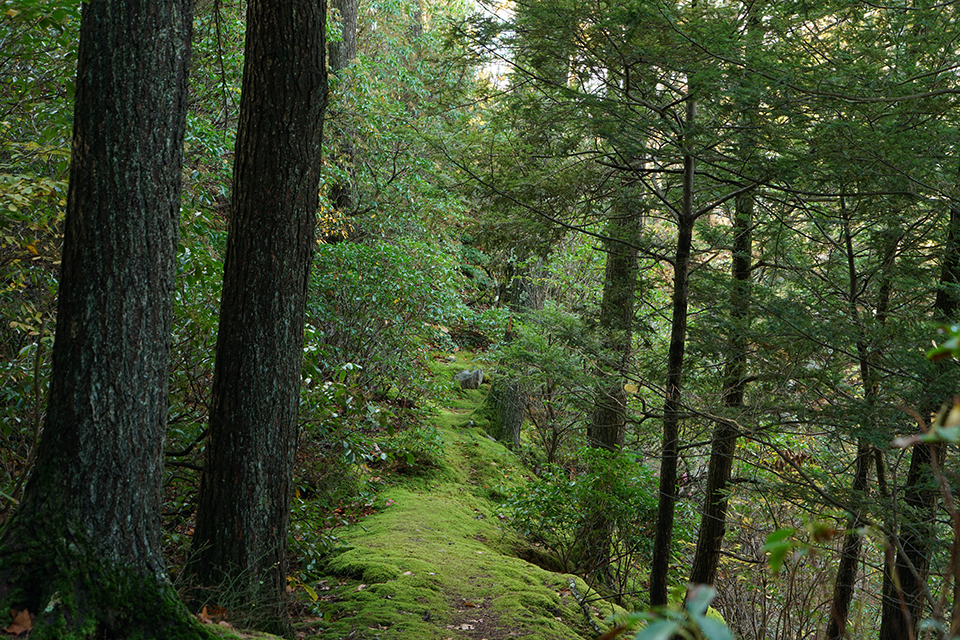 View of Wright’s “Moss Room,” Manitoga, Garrison, N.Y, date unknown. Photo by Rick Darke, courtesy Manitoga/The Russel Wright Design Center.
View of Wright’s “Moss Room,” Manitoga, Garrison, N.Y, date unknown. Photo by Rick Darke, courtesy Manitoga/The Russel Wright Design Center.
In 1984 Manitoga, Inc., (now Manitoga/The Russel Wright Design Center) was established to preserve and share Wright's legacy, his home, landscape, products, and philosophy. The site was listed in the National Register of Historic Places in 1996, and in 2006 was designated a National Historic Landmark. Despite these milestones, Manitoga was threatened by deferred maintenance and by an invasive insect (the Hemlock woolly adelgid). The insect killed thousands of eastern hemlock trees on the property; these trees were originally part of an overall frame for the landscape, creating, with their dense shade and low-branching character, dramatic settings of light and shadow. Due to a lack of funding, Manitoga's staff were unable to care for many of the special features along Wright's paths, particularly in the outer landscape.
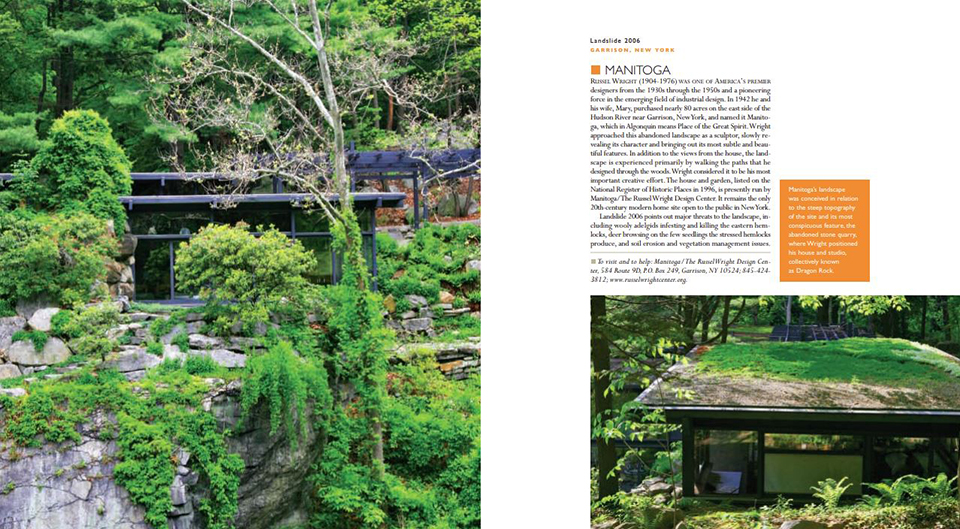
Manitoga featured in Garden Design magazine, June 2006. Image courtesy the Cultural Landscape Foundation.
Advocacy and Engagement for Manitoga
To raise Manitoga’s visibility, spur discussion about its future, and promote positive change, TCLF included Manitoga in the 2006 Landslide thematic report and digital exhibition, Spotlight on the Garden, which focused on fourteen significant at-risk landscapes throughout the United States. TCLF outlined several concrete steps to help steward Manitoga, including donating funds and supplies, volunteering, underwriting a lecture series to showcase Wright’s genius in ecological design and management, and supporting a full-time landscape assistant. The Landslide report also drew attention to the excellent work underway at the site.
In October 2010 Manitoga welcomed TCLF’s president and CEO, Charles A. Birnbaum, as a speaker at the fourth annual Woodland Landscape Program. Birnbaum’s lecture, titled Why Cultural Landscapes? addressed the stewardship of cultural landscapes and how they contribute to the understanding of our shared past. TCLF organized a tour of the site as part of the day-long Hudson Highlands Garden Excursion in June 2011, and again spotlighted Manitoga in 2017 in the program Garden Dialogues: Modernist Milestones, alongside Caldwell Farm in Bristol, WI; the James Rose Center in Ridgewood, NJ; and the Noguchi Museum in Queens, NY. As part of the TCLF event at Manitoga, author, landscape architect, and stone aficionado, Jan Johnsen, offered unique insights into the design of the woodland garden. Ongoing restoration of character-defining landscape features such as Mary’s Meadow, the Quarry Amphitheater, and various woodland footpaths and water crossings, continue at Manitoga, carefully reflecting Wright’s original design intent. The newly replanted Vernal Pool is protected by a deer fence and is approached by an accessible path. The hemlock woolly adelgid infestation and invasive species continue to be challenges and are being managed through treatment and removal. A graceful entry drive through a wildflower meadow now welcomes visitors, and the seamless integration of landscape and architecture is in clear view with the restored green roofs of Dragon Rock.
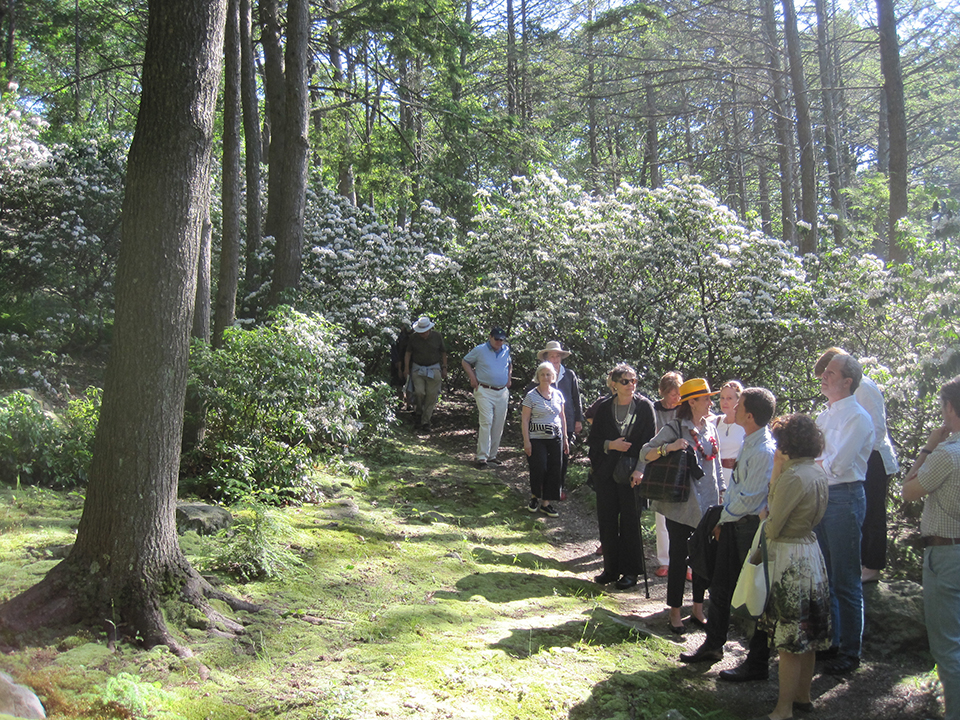 Tour of Manitoga during Hudson Highlands Garden Excursion, Garrison, N.Y., 2011. Photo by Charles A. Birnbaum, courtesy The Cultural Landscape Foundation.
Tour of Manitoga during Hudson Highlands Garden Excursion, Garrison, N.Y., 2011. Photo by Charles A. Birnbaum, courtesy The Cultural Landscape Foundation.
Most dramatic is the recent restoration of the Wright-designed 30-foot waterfall, deemed to be at risk of imminent loss without stabilization. This project is part of the larger Quarry Landscape Restoration, which is at the very heart of Manitoga. Next will be the conservation of the Quarry Pool to include dredging and edge rehabilitation. Planning for this and for all future projects will address the challenges posed by extreme weather events and increased stormwater. A notable recent achievement at Manitoga is the opening of The Russel & Mary Wright Design Gallery, where more than 200 of the Wrights’ groundbreaking product designs that brought modernism to millions at midcentury are seen in the context of the landscape that inspired much of their creation.
According to Vivian Linares, Program Director and Director of Collections, Interpretation and Historic Preservation at Manitoga, TCLF’s initial Landslide listing “was an important recognition for Manitoga and helped energize all that followed.”
Situated less than half a mile east of the Hudson River, this 250-acre estate was developed and designed between 1860 and 1890 by renowned Hudson River School landscape painter Frederic Edwin Church in collaboration with Calvert Vaux. Conceived as an integrated environment embracing architecture, art, and landscape, the name Olana first appeared as the heading of a letter written by Isabel Church, Frederic’s wife. As explained in a contemporary newspaper article, it is “the old Latin name for a place in Persia, to which the artist’s home bears some resemblance in situation.” The estate was meant to serve both as a major aesthetic statement and as a home for Church's family. The result is a landmark of Picturesque landscape design with a Persian-inspired house at its summit, offering unrivaled panoramic views of the Hudson Valley that are emblematic of the era’s idealized mix of agrarian and wilderness landscapes.
Background
In 1860, two months before his marriage to Isabel Carnes, Church purchased 126 acres of farmland at the base of Long Hill, or Sienghenbergh. He maintained the property as a working and ornamental farm, retaining its orchards and fields. Church established five miles of drives to provide access; these present a sequence of hide-and-reveal views in which framed woodland vistas are interlaced with open meadows and cultivated farmland. In 1864 Church purchased additional land and designed more drives, cleared vegetation to establish views, planted “thousands and thousands” of trees, and converted a wetland into a ten-acre, forest-ringed lake. By 1867 he had acquired the remaining eighteen acres atop Long Hill, choosing it as the setting for his new residence and studio. Church engaged architect Calvert Vaux and the two collaborated on the design of the house. Completed in 1872, the main house, along with its adjacent stable, service yards and lawns, is reached by a circular final approach drive that dramatically presents the house and its setting.
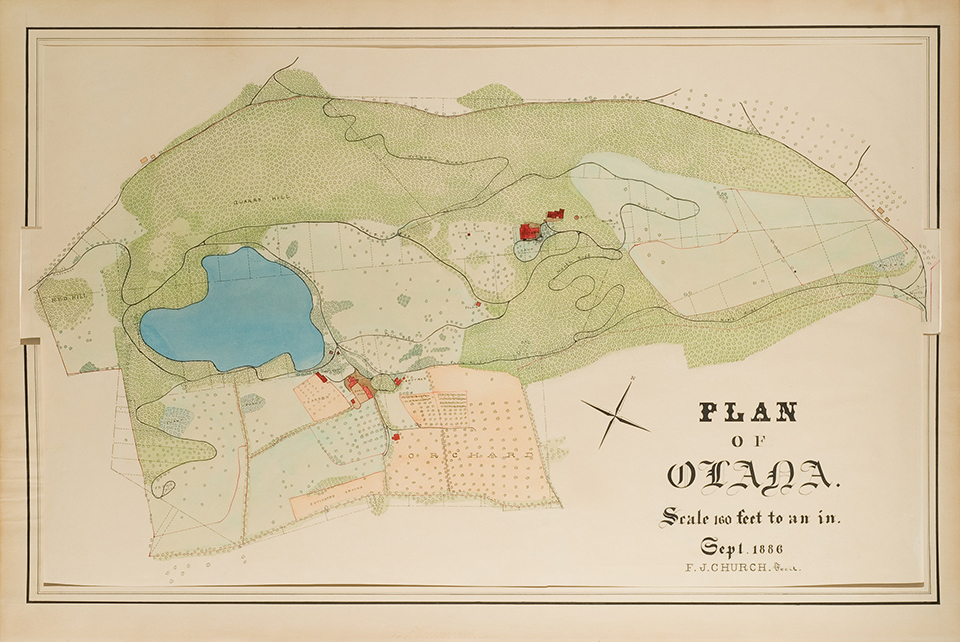 Plan of Olana, Hudson, N.Y., 1886. Plan by Frederick Jospeh Church, courtesy Olana State Historic Site, NYS OPRHP.
Plan of Olana, Hudson, N.Y., 1886. Plan by Frederick Jospeh Church, courtesy Olana State Historic Site, NYS OPRHP.
Upon Church’s death in 1900, the estate was inherited by his youngest son Louis, who, along with his wife, Sally Good, lived there the remainder of his life. Unfortunately, Louis altered the property and its existing structures, allowing open meadows to grow over, removing the apple orchards, and converting the east lawn to an elaborate, walled flower garden with a fountain. When he died in 1941 his wife Sally stopped all expenditures on the property and abandoned the farming, allowing the fields to revert to woodland. After her death in 1964, family members were unable to maintain the large property and the contents of the house were to be auctioned, the house demolished, and the land sold. Following a two-year effort to save Olana, a group of citizens, with the assistance of the New York State Legislature and then-Governor Nelson Rockefeller, succeeded in raising the requested amount and purchased the property. The estate was designated a National Historic Landmark in 1965, and Olana State Historic Site was opened to the public in 1966.
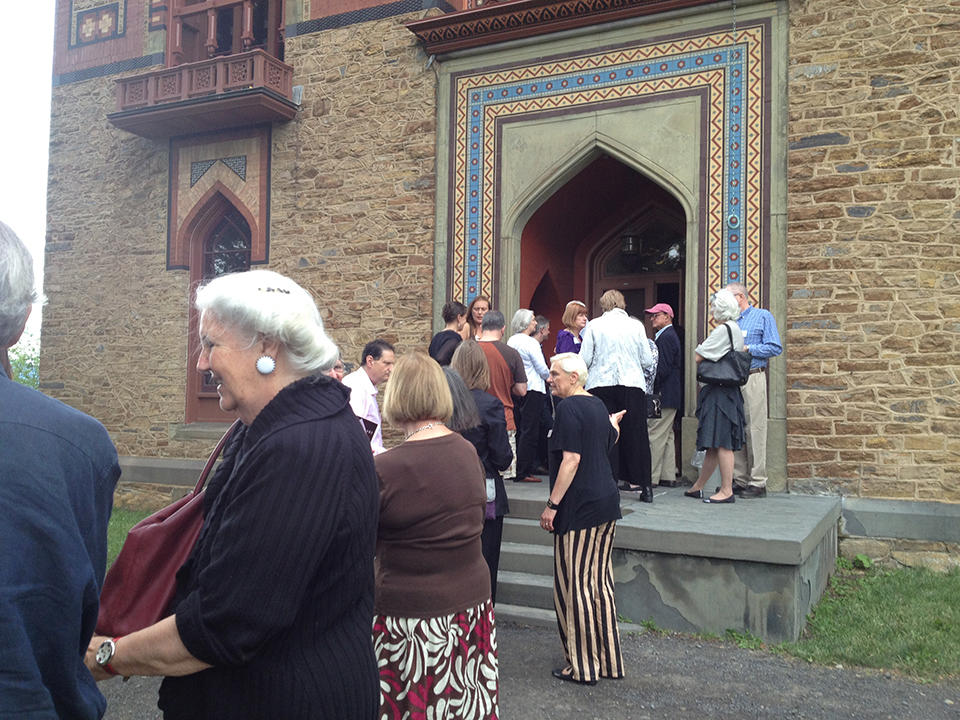
Key stakeholder gather during a TCLF workshop at Olana, Hudson, N.Y., 2013. Photo by Charles A. Birnbaum, courtesy the Cultural Landscape Foundation.
Advocacy and Engagement for Olana
A historic landscape report was commissioned in 1966 and a landscape restoration plan published in 2002. During this time, The Olana Preservation’s successor organization, The Olana Partnership (TOP), and New York State targeted small landscape projects, including selective clearing to open views, replanting a small portion of the orchard, and burying utilities lines. Even with these accomplishments, Olana’s landscape remained threatened. Winter storms littered the property with ice-damaged trees, and staff shortages hindered clean-up efforts. In some areas regular maintenance was deferred, allowing invasive plants to take hold in the lake and surrounding areas.
TCLF has been a staunch advocate for and trusted advisor to Olana for more than a decade. The site was included in the 2009 Landslide thematic report and digital exhibition Shaping the American Landscape. In 2010 TCLF organized a panel of expert historians and historic landscape stewards who discussed the relationship between two of America’s greatest nineteenth-century Romantic landscapes: Central Park in New York, and Olana. Two of the speakers were curators at Olana.
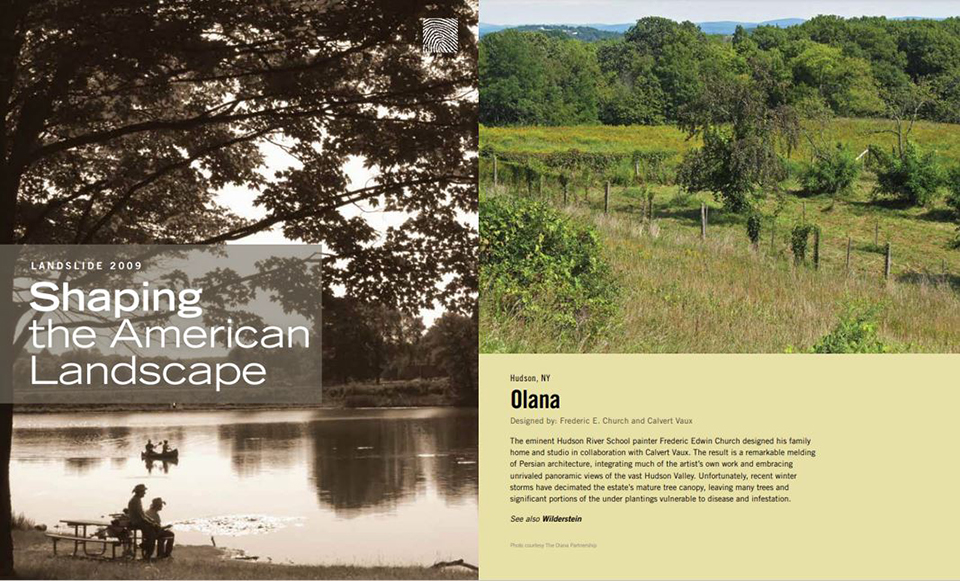 Landslide 2009: Shaping the American Landscape featuring Olana, Hudson, N.Y. Image courtesy The Cultural Landscape Foundation.
Landslide 2009: Shaping the American Landscape featuring Olana, Hudson, N.Y. Image courtesy The Cultural Landscape Foundation.
Beginning in 2010 the trustees and staff of TOP began to shift their focus towards Church’s designed landscape and its integral viewshed and increased the number of landscape management projects and related interpretation efforts. In 2011 TCLF’s President and CEO Charles A. Birnbaum worked with TOP to develop a “white paper,” titled Managing Change at Olana. In March of that year Birnbaum authored the article “The Value of View” for the Huffington Post, featured on TCLF’s website, noting that Church’s pivotal role in the genesis of America’s conservation movement should not be ignored, and that TOP should assign significance and value to its cultural landscape through the lens of “borrowed scenery,” or the vistas beyond the property’s boundaries (including river, neighboring hills, valleys, and distant mountains), which are one of Olana’s defining characteristics. The next month, with TCLF as a sponsor, TOP hosted a symposium (the first in a series), called Framing the Viewshed: The Transformative Power of Art and Landscape in the Hudson Valley. Featuring Linda S. Ferber, Harvey K. Flad, and Laurie Olin, with David Schuyler as moderator, the talks connected Hudson River School artists and their early conservation efforts to the modern environmental movement and contemporary landscape design.
Following significant viewshed protection accomplishments, TOP continued to work with organizations such as Scenic Hudson to safeguard significant views from the property. To date, thousands of acres of borrowed scenery east and west of the Hudson River have been protected largely through conservation easements and cooperation with private landowners. Funded through New York State grants and private donations, TOP has spearheaded a number of important landscape initiatives and engaged landscape architects including Thomas Woltz of Nelson Byrd Woltz Landscape Architects.
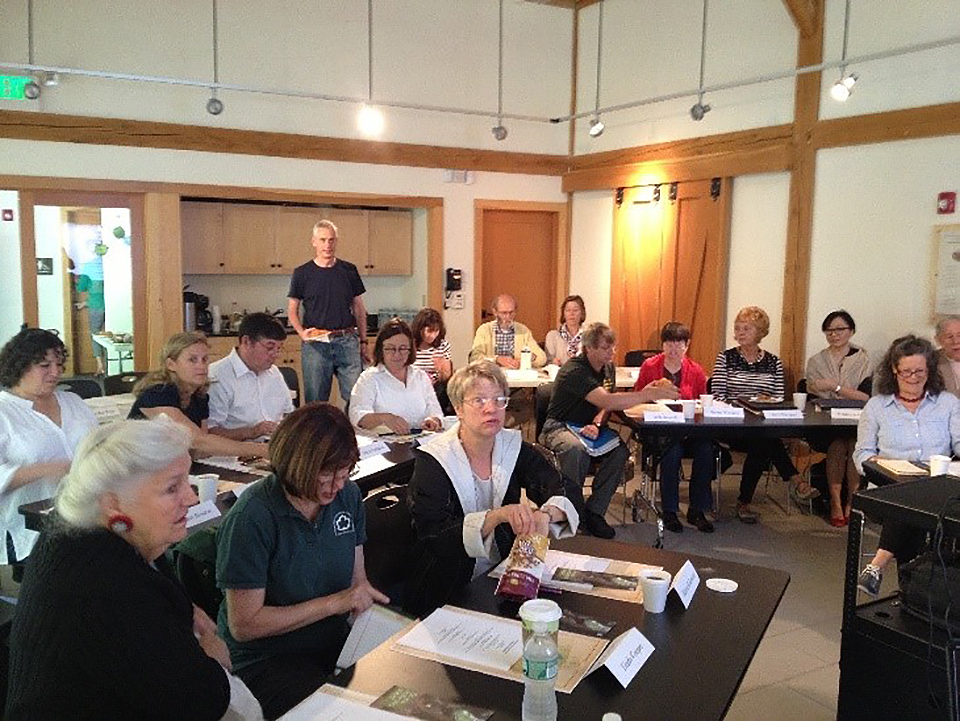 TCLF workshop at Olana, Hudson N.Y., 2013. Photo by Charles A. Birnbaum, courtesy The Cultural Landscape Foundation.
TCLF workshop at Olana, Hudson N.Y., 2013. Photo by Charles A. Birnbaum, courtesy The Cultural Landscape Foundation.
In 2015 the New York State Office of Parks, Recreation and Historic Preservation worked with TOP and commissioned Nelson Byrd Woltz and The LA Group to produce a Strategic Landscape Design Plan (SLDP) that was aimed at achieving a more holistic stewardship, one mindful of the historic relationship between the residence, its landscape, and the greater context of the Hudson Valley. Research-informed maps and diagrams allowed the designers to re-establish historical viewsheds, identify the historic core, and resolve the siting of the proposed visitor center. Landscape historian Suzanne Turner served as a consultant for this plan and developed an extensive timeline related to Olana’s landscape.
In its Garden Dialogues 2017: Artists in Residence, TCLF explored the relationship between artists and their personal landscapes, featuring Olana along with other sites. Several of these were Historic Artists’ Homes and Studios (HAHS) sites. For the Olana dialogue, acclaimed landscape photographer Larry Lederman was in dialogue with Julia B. Rosenbaum, Associate Professor and Chair of Art History at Bard College and Olana’s Director of Research and Publications.
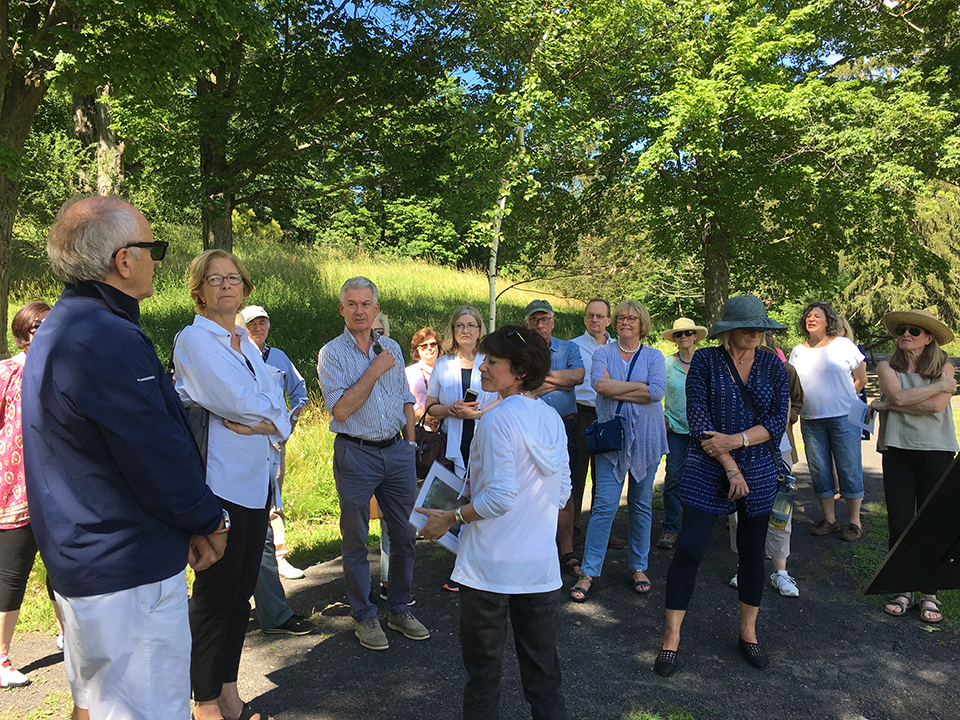 Garden Dialogues 2017: Artists in Residence, Olana, Hudson, N.Y., 2017. Photo courtesy The Cultural Landscape Foundation.
Garden Dialogues 2017: Artists in Residence, Olana, Hudson, N.Y., 2017. Photo courtesy The Cultural Landscape Foundation.
Looking ahead, TOP intends to install a new visitor center and orientation facility, as proposed in the SLDP. The proposed site, a wooded setting adjacent to the main entry drive, was selected so the structure would not be visible from the main house or anywhere within the core landscape. Nelson Byrd Woltz has been engaged to develop the design, alongside architecture firm Architecture Research Office.
Located in the Catskill Mountains approximately 100 miles north of New York City, this 6.5-acre site comprises the masterwork of self-taught sculptor Harvey Fite. In 1938 Fite, a professor of art at Bard College, purchased an abandoned quarry for its bluestone to be used in his figurative sculpture. Shortly thereafter, he spent several months at Tikal and Copán in Honduras restoring Mayan architecture, where he was inspired by the beauty and resilience of dry-stacked stone constructions.
Background
Responding to the site’s existing conditions and using traditional quarryman’s tools and techniques, Fite laid millions of pieces of bluestone by hand without mortar to construct a series of curvilinear terraces connected by stepped and sloping pathways. Surrounded by aspen, birch, and pine, Fite preserved native vegetation and naturally occurring pools of water. Tiered platforms provide access to broad vistas while a network of ramps, bridges, and stairways terminate at exposed bedrock sixteen feet below grade.
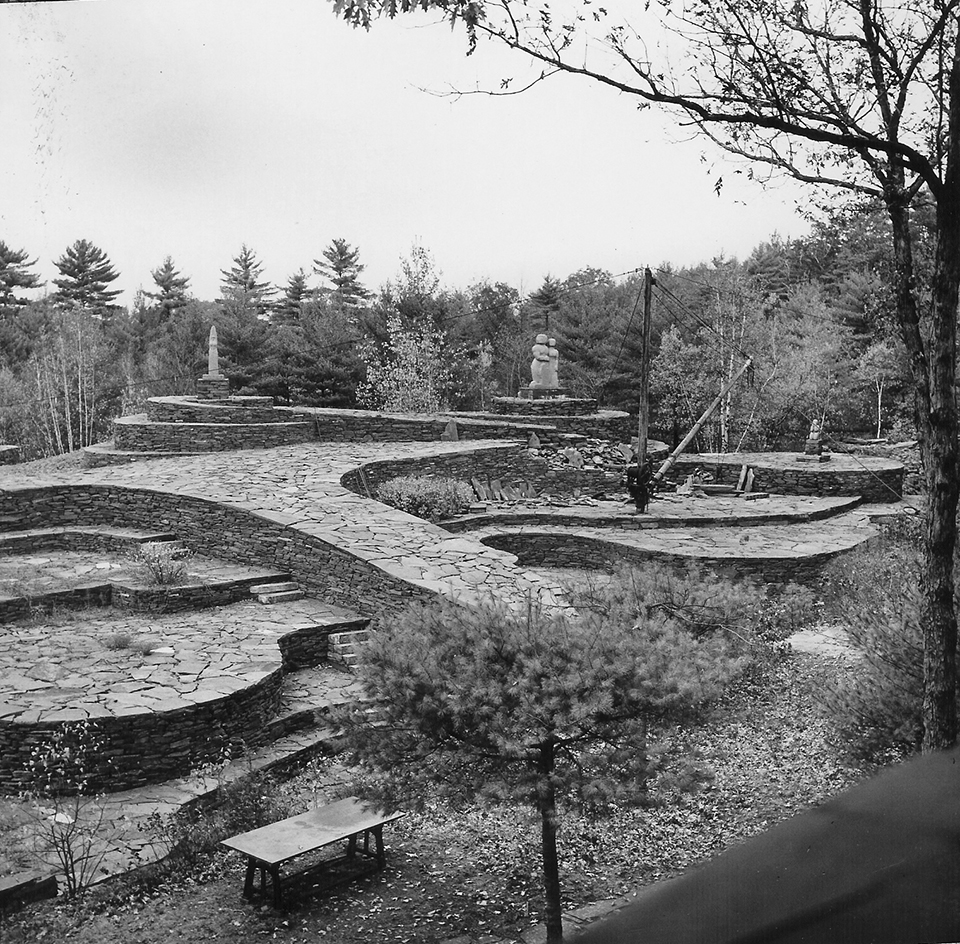 Opus 40 during construction, Saugerties, N.Y., circa 1950s. Photo courtesy Opus 40.
Opus 40 during construction, Saugerties, N.Y., circa 1950s. Photo courtesy Opus 40.
Though the site was originally intended to be used as exhibition space, the artist eventually grew to believe that the site itself was the sculpture. Twenty years after commencing the work, Fite erected a nine-ton asymmetrical bluestone monolith at its center to serve as a focal point. He worked alone from 1939 until he accidentally fell to his death in 1976, after which his widow, Barbara Fite, opened the site to the public. Named for the number of years Fite thought he would work on the installation, Opus 40 was listed in the National Register of Historic Places in 2001.
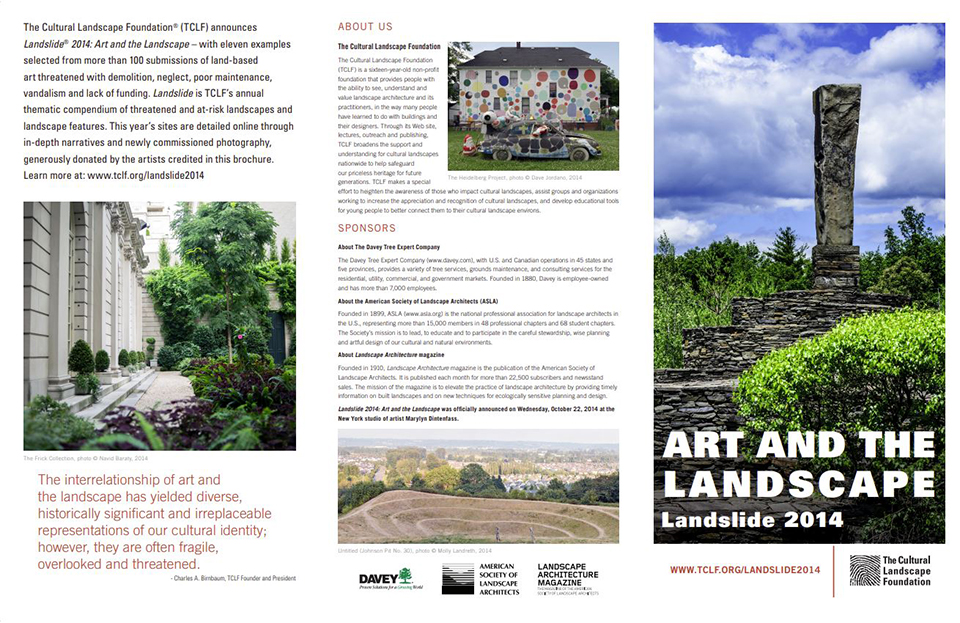
Landslide 2014: Art and the Landscape brochure featuring Opus 40 on the cover. Image courtesy The Cultural Landscape Foundation.
Advocacy and Engagement for Opus 40
Over the next two decades, the site suffered most notably from hurricane damage. TCLF enrolled Opus 40 in the 2014 Landslide thematic report, Art and the Landscape. The report and digital exhibition (which included the Frick Collection’s Russell Page Viewing Garden and Untitled Earthwork (Johnson Pit #30), also in this year’s report), highlighted eleven examples of land-based art – from ancient petroglyphs to earthworks, folk art creations, single artist, multi-acre installations, and others – threatened with demolition, neglect, poor maintenance, vandalism, and lack of funding.
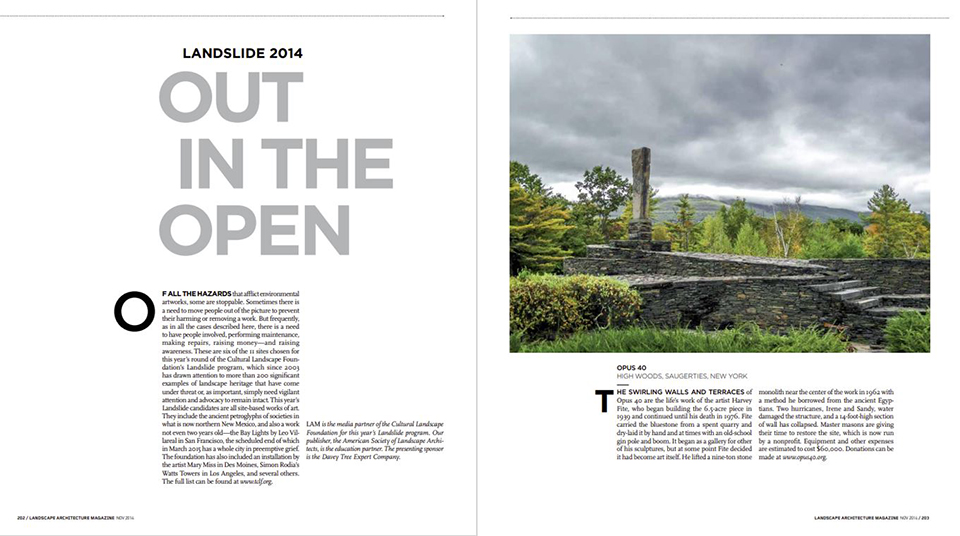 Landslide 2014: Art and the Landscape article in Landscape Architecture Magazine, featuring Opus 40, Saugerties, NY.
Landslide 2014: Art and the Landscape article in Landscape Architecture Magazine, featuring Opus 40, Saugerties, NY.
TCLF drew attention to the damage caused to Opus 40 by Hurricanes Irene (2011) and Sandy (2012). Water buildup exacerbated by both storms had caused a fourteen-foot-high vertical wall in one of the oldest parts of the site to collapse. Expert stonemasons had been enlisted to consult on the damage and restore the site. In the summer of 2012, master stonewaller Sean Adcock of North Wales, United Kingdom, and Tomas Lipps of the Stone Foundation in Santa Fe, New Mexico, led a team in taking down and rebuilding a portion of Opus 40’s eleven-foot-high central ramp to demonstrate the feasibility of restoring the collapsed wall. Although they offered their time at a fraction of their normal rates, the undertaking was still costly. TCLF encouraged its supporters to contribute to the fundraising campaign for the restoration work. In 2014 a team led by stonemason Timothy Smith of Clermont, New York, completed prep work for the restoration, removing and stacking the loose stone. The final phase of the restoration, headed by Adcock, was completed in 2015.
Following her husband’s death, Fite’s wife Barbara created a non-profit to oversee site maintenance and manage public access. After her death in 1987 her stepson, Tad Richards, continued to run the non-profit and the adjacent family home, also built by Fite. Richards’ decision to rent out the house, allowing guests to camp nearby, caused an uproar in the community, and in 2021 Fite House was separated from the Opus 40 Sculptural Park by a chain-link fence.
The fence was eventually removed, and in late 2021 Opus 40 Sculpture Park received a $300,000 conservation grant from the Andrew W. Mellon Foundation, matching an award of the same amount from the National Park Service’s Save America’s Treasures program. This funding allowed the site to undertake essential stabilization and repair work.
In 2022 the Fite House was listed for sale at $1.5 million; in February 2023 Opus 40 Sculpture Park reached an agreement with Bard College to purchase the historic home, finally reuniting Fite House and Opus 40 as a single, unified site. The purchase was made possible in part by support from the Thompson Family Foundation, the New York State Assembly, and the town of Saugerties. Before being opened to the public, the house will require extensive repairs; Opus 40 will launch a capital campaign to raise the funds, and the work will likely take two to four years to complete. Once the house fully opens to the public, Bard College will provide programming support, including educational programs, workshops, and faculty residencies.
Selected Resources
Garden Dialogues 2018: Millbrook, NY
“Lester Collins’ Innisfree Listed in National Register,” November 11, 2019
2017 Garden Dialogues: Modernist Milestones
“Garden Dialogues 2017: NY – Glorious Olana,” August 26, 2017
“Recent Developments at Frederic Church’s Olana, September 23, 2016”
“Funding Awarded to Opus 40 for Critical Repairs,” January 14, 2022
Selected Media Coverage
“Can a Legendary Iris Garden Survive?” Anne Raver, New York Times, May 18, 2006 “Understanding Ourselves Through Cultural Landscapes,” Alison Rooney, The Highlands Current, October 22, 2010 “The Cultural Landscape Foundation to Feature Several HAHS Sites in Garden Dialogues 2017,” Historic Artists’ Homes and Studios “Opus 40 in Saugerties put on list of nation’s endangered landscapes,” Daily Freeman News, October 22, 2014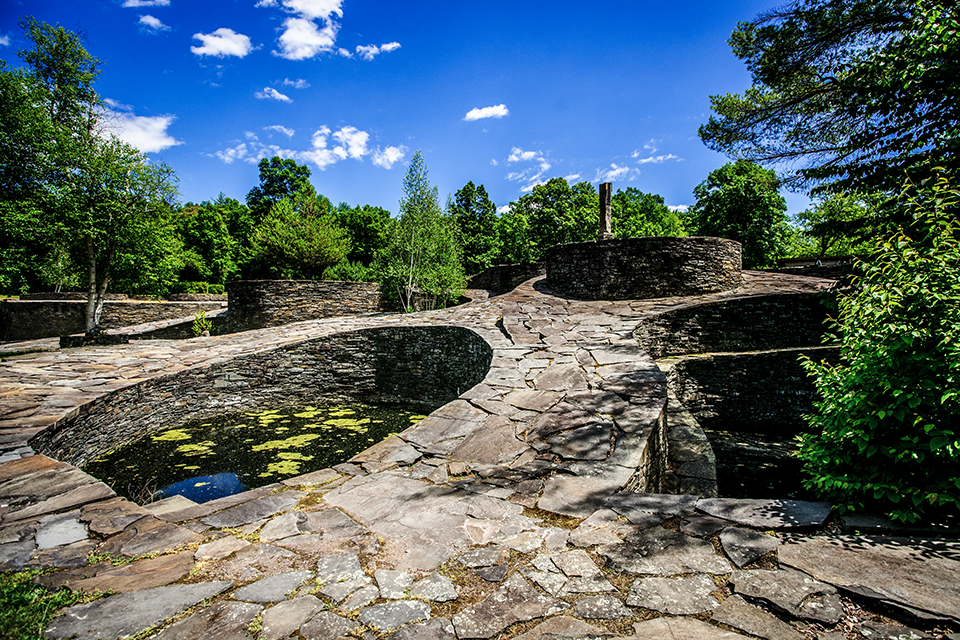
-
Opus 40, Saugerties, NY, 2014. Photo by Thomas Hahn.
